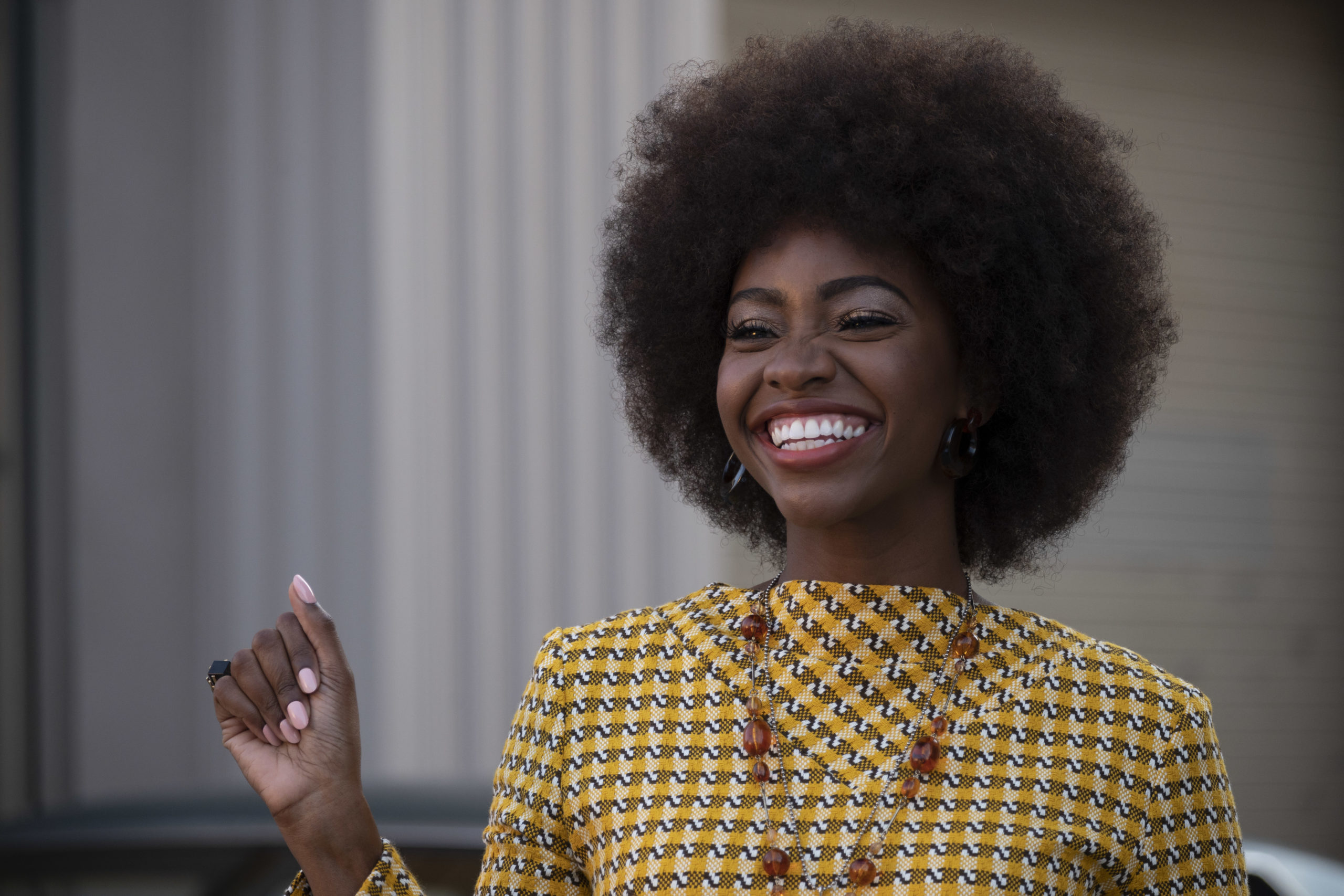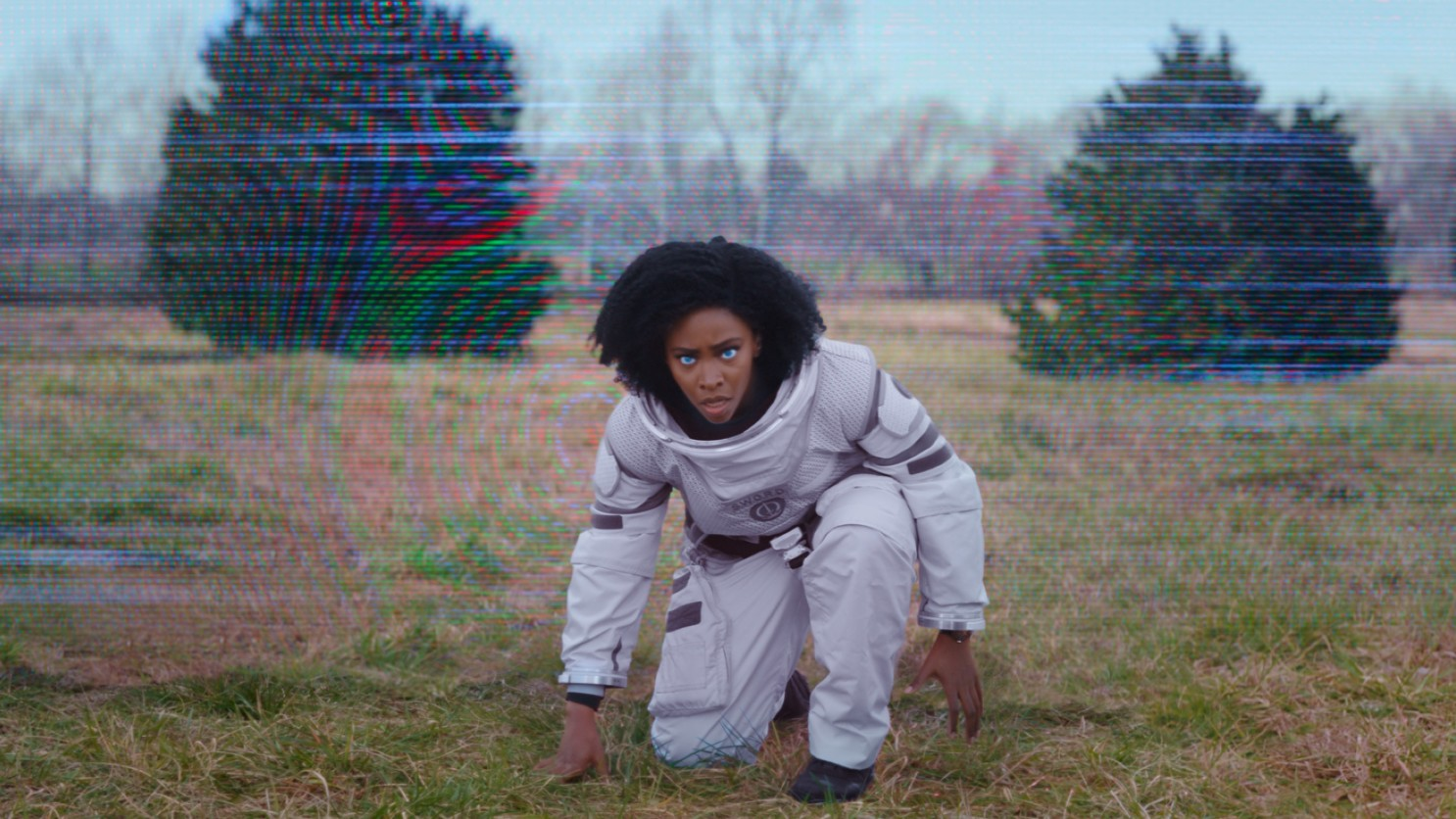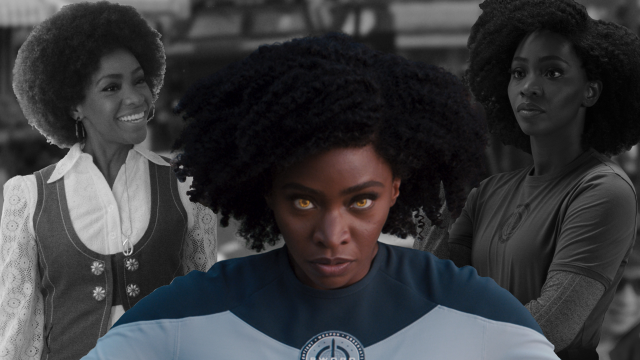Though WandaVision was always a show about the Avengers’ Sokovian juggernaut confronting the stifling grief that’s been plaguing her since she first showed up in the Marvel Cinematic Universe, the series was also the world’s introduction to Teyonah Parris’ Monica Rambeau, the now-adult daughter of Maria Rambeau who first appeared in Captain Marvel. The promise of her role loomed large over the Disney+ series, but by the end, it turned Monica’s second debut into a haphazard crash landing that’ll be hard to shake off for the comics’ first female Captain Marvel.
Though Monica’s frequently fought alongside and led the Avengers in Marvel’s comics, her relatively thin canonical history with Wanda Maximoff in particular made the character’s presence in WandaVision one of the more intriguing question marks looming over the series. Many of those same question marks became bolded and italicised when Parris arrived in WandaVision’s second episode, “Don’t Touch That Dial,” as “Geraldine,” one of Westview’s few Black residents and the only person (aside from Kathryn Hahn’s “Agnes”) who actually tried to welcome Wanda into the town’s social scene.
[referenced id=”1665107″ url=”https://gizmodo.com.au/2021/01/wandavisions-teyonah-parris-promises-more-of-monica-rambeaus-backstory/” thumb=”https://gizmodo.com.au/wp-content/uploads/2021/01/16/k8dkwztgqaoco2qhmbuq-scaled-e1610915381483-300×164.jpg” title=”WandaVision’s Teyonah Parris Promises More of Monica Rambeau’s Backstory” excerpt=”It isn’t until WandaVision’s second episode that Teyonah Parris actually makes her first appearance in the Marvel Cinematic Universe. She’s one of the many people living alongside Wanda Maximoff (Elizabeth Olsen) and Vision (Paul Bettany) in the small town of Westview, where the most pressing thing on most everyone’s mind…”]
Through Geraldine and Westview’s other residents, WandaVision showed you how the chaos emanating from Wanda warped the space around her into idealised, sitcom-like settings that worked to mask the pain and sadness that defined Wanda’s life outside of the Hex. While Geraldine and Wanda’s friendship began with the two women leaning on one another for support in tricky social situations, their dynamic takes an interesting turn in “Now in Colour,” when Wanda finds herself suddenly pregnant and losing control of her powers. Though the series wouldn’t spell out the direct connection between Wanda’s level of stress and the Hex’s faltering until much later in the season, “Now in Colour” brought Monica into the picture with a convenient explanation: her house flooding right when Wanda’s contractions began to intensify. As Wanda nervously attempted to hide her very obvious pregnancy from Geraldine, the episode gave us a sense of the affinity for one another that the two women developed as part of WandaVision’s overarching throughlines.

Though Geraldine was deep in the Hex’s thrall, when it became apparent that Wanda was on the brink of giving birth to her twins, she thought nothing of lending Wanda a hand despite the strangeness of the situation. The very brief moment of true vulnerability shared between them during the birth is contrasted sharply by the way Wanda turns on Geraldine later in the episode, when Geraldine (now seemingly free of Wanda’s influence) begins to question Wanda about her real-world past.
Wanda flinging Geraldine out of Westview and then lying to Vision about what happened made it abundantly clear that Wanda herself was a strong contender for being WandaVision’s true villain, an idea that’s become well-worn in the comics. But Geraldine’s exit also served as Monica’s proper entrance to WandaVision, as she became the focal point of the series’ stories taking place outside of the bewitched town.
“We Interrupt This Program” used Monica to bring the audience up to speed about what coming back from Thanos’ snap was like for the rest of the world away from the action during Avengers: Endgame. By focusing on Monica, though, the episode grounded the gravity and impact of the return in her experience and decision to jump right back into her former life, something that forced her to confront the reality that she’d been gone from the world for years. Although there was much about Monica’s relationship with her now-deceased mother and Carol Danvers that WandaVision could have explored, the series instead led with Monica’s focus on her work with SWORD Director Tyler Hayward, Jimmy Woo, and Darcy Lewis. Placing Monica outside of the Hex took her out of Wanda’s orbit, but it put her into a new space that worked well to complement the series’ exploration of identity, womanhood, and power.
[referenced id=”1668339″ url=”https://gizmodo.com.au/2021/01/wandavisions-menacing-signal-is-finally-cutting-through-the-noise/” thumb=”https://gizmodo.com.au/wp-content/uploads/2021/01/30/xv8xkldqmte0vhfzizaj-e1612127415427-300×156.png” title=”WandaVision’s Menacing Signal Is Finally Cutting Through the Noise” excerpt=”After WandaVision’s first three episodes, the series was in the position to make a choice whether to keep on focusing specifically on Wanda and Vision’s suburban bubble reality, or finally shift focus to one of its other characters like Monica Rambeau, whose perspectives might provide some important information about the…”]
At the same time that Wanda was playing with those concepts within her magical hexagon of domesticity, Monica was doing something similar in her public/professional SWORD-shaped sphere where Wanda was deemed a threat. Monica and Hayward’s opposing ideas about how to deal with the Avenger were mapped onto the traditional civilian hero and villain perspectives you see in many comic book movies.
As someone who experienced the Hex firsthand, Monica understood how it violated and tortured the people trapped within it, but also genuinely believed Wanda to be a good person despite her responsibilities. Hayward, a military type with little capacity for nuanced thinking, instead saw Wanda as an outsized danger that SWORD needed to neutralise. Though those positions would have served WandaVision well enough, the series used Hayward and Monica’s tension to touch upon a thorny, important element of the show’s conceit that was most obvious in its first few episodes that were meant to evoke the mid-20th century.
Even though there was nothing especially offensive about Geraldine’s depiction in “Now in Colour” or any of WandaVision’s episodes before it, when Hayward, Monica, and the rest of SWORD all take in a brief clip of her last appearance on the Hex’s broadcast, you can sense the uncomfortable feeling in the room. Beyond turning on Monica and potentially harming her, the shot of Geraldine on SWORD’s monitor was a reminder that, on some level, she was the only kind of period-appropriate character Wanda could envision for a Black woman.

It feels necessary to pause for a moment and really highlight how fascinating that aspect of WandaVision’s worldbuilding was because of how it worked as a reflection of the show’s desire to truly celebrate sitcoms as a medium — something that didn’t have to mean shying away from Hollywood’s historical lack of thoughtful roles for Black characters.
Two-dimensional as Hayward was, giving him even the smallest amount of understanding of how the Hex’s optics and material affected Monica made him an infinitely more interesting villain even as the show gave up on trying to hide his true motivations. The reality that supremely qualified Black women face undue obstacles and hostilities in the workplace is something we’ve seen explored with Luke Cage’s Misty Knight and, in a slightly different way, with characters like Black Mariah and Nightshade. With Monica, WandaVision used this idea to briefly begin digging into a study of how those challenges to Black women’s authority and skillsets follow them from one setting to another.
Monica takes matters into her own hands in “Breaking the Fourth Wall” with a plan that involves ramming into the Hex with a specialised tank of her own design. The barrier makes short work of the vehicle but she risks it all by trying to force her way into the Hex using just her body. Had WandaVision spent a bit more time letting us get to know Geraldine, the sequence of Monica and the different Geraldines fighting their way through the Hex might have landed a bit heavier. But the series of voices from Monica’s past echoing in her mind works as she pulls herself together and bursts from the Hex with newly glowing eyes and a mission.
Looking back at WandaVision, you can see that things began to turn south for Monica’s arc basically the moment she bursts back into Wanda’s home in yet another attempt to reason with the same woman who’d previously made it quite clear that she was through holding back. Monica’s still-undefined powers ended up protecting her from any damage Wanda might have done by slamming her into the footpath in front of her neighbours, but they couldn’t save her from being cast aside in the series’ last few episodes, which were ambitious to the point of seemingly sapping the energy out of everyone else’s storylines.

It’s likely important to bear in mind that WandaVision’s production came to a sudden stop last autumn as covid-19 swept across the world and ground Hollywood to a halt. It still isn’t clear whether the show’s pandemic production issues dramatically impacted its story, but things like the way Monica just kind of disappears after Agnes casually told her to run off while consoling a distraught Wanda make it feel as if things were left on the cutting room floor.
After Monica’s special eyes lead her to Agnes’ basement, she’s caught by “Pietro” (Evan Peters), and the two characters disappear altogether until “The Series Finale,” which finds Monica trapped in Pietro/Fietro Ralph Bohner’s home, and quite bored. Given WandaVision’s time constraints, it wouldn’t have made much sense for the show to feature an all-out series of hero moments for Monica in the finale, which was all about Wanda finally becoming the MCU’s Scarlet Witch, but again, her storyline did feel oddly cut short. What the episode did do, however, was draw rather directly from Al Ewing’s run on Mighty Avengers that first saw Marvel Comics’ Monica adopting her Spectrum monicker.
[referenced id=”1668769″ url=”https://gizmodo.com.au/2021/02/wandavisions-first-major-mcu-connection-was-a-fascinating-moment-of-terror/” thumb=”https://gizmodo.com.au/wp-content/uploads/2021/02/02/ekkdao1nthkpawtlj0yz-300×169.png” title=”WandaVision’s First Major MCU Connection Was a Fascinating Moment of Terror” excerpt=”One of the things people crave most about Marvel’s cinematic output? Connection. Where is this character during this moment, how does this event connect to a hundred other narratives? WandaVision, Marvel Studios’ first crack at bringing its movieverse to streaming television, is no exception, but it’s doing so in a…”]
The scene where WandaVision’s Monica jumps in front of gunfire from Hayward to shield Wanda’s twins Billy and Tommy feels like the series’ take on a moment from Ewing, Greg Land, Jay Leisten, and Frank D’Armata’s Mighty Avengers #5, in which Monica takes on SHIELD agent Barbara McDevitt, an Inhuman with the ability to manipulate time. By the time McDevitt fires off a trio of bullets that harmlessly pass through Monica’s light form, this run of Mighty Avengers not only established what Monica’s powers were, but used the depiction of her wielding them with skill to convey that she wasn’t new to superheroing.
Ewing’s Mighty Avengers opened with a story about how Avengers like Monica and Luke Cage decided get back into the vigilante business of their own volition with a deep understanding of the situations they were getting into. WandaVision’s finale brought Monica back into the story having gone through a personal transformation, but with no real role to play in the text other than to selflessly put herself in harm’s way for Wanda’s family. On paper, jumping in front of bullets is an idea we can identify as being inherently heroic, because it is. But when stories choose to centre images of Black characters being shot at — especially by white authority figures — that story’s creators are tapping into a very specific set of ideas and hard truths about how Black people are brutalized both in real life and the fiction attempting to reflect it.

Grappling with the ugly truths that exist in this space isn’t an inherently bad thing at all; movies like Black Panther and series like Black Lightning and Batwoman have touched upon it in their own stories. If WandaVision had actually done a better job of contextualizing Monica’s decision to catch a few bullets for a stranger’s fantasy children, it likely still would have left her and Wanda on uncertain terms with one another by the series finale, but it wouldn’t have felt as if the show went out of its way to almost use Monica as a thankless emotional doormat.
In a very real way, Wanda Maximoff became the embodiment of a particular kind of besieged white womanhood that’s achieved mythic status — both in pop culture and our everyday lives — in ways worth paying attention to. It would be reductive and mildly out of fashion to describe Wanda as the “Scarlet Karen,” but in many moments towards WandaVision’s end, that’s what it felt like she was becoming. Though Agnes’ reveal as Agatha framed her as the series’ secret villain, her final confrontation had the effect of recasting their story as one about white women trying to take hold of a power capable of freeing them from their respective struggles. In their fight for that power, Agatha got her comeuppance and the hint of future appearances, Wanda became a living goddess, and Monica, easily one of WandaVision’s leads, was set up to continue her journey in Captain Marvel 2.
But before Wanda abruptly exits Westview with little attempt at apologizing for enslaving the townspeople, WandaVision brings her and Monica back together. In their brief conversation, Monica insists that Wanda’s still a person deserving of sympathy because she had to “give up” her family in order to break her spell. While it’s very nice to think that one would choose to be the bigger person after being possessed and attacked by a witch, this characterization for Monica given everything else that happens to her in the series felt like an unnecessary misstep that cast an unignorable shadow over the series as a whole. By not sticking its landing, all of WandaVision’s subtle sleights against Monica lose their ability to work as dynamic texture to the story and more like a reminder of how the show missed a choice opportunity to point out how Black sitcoms were huge for a hot second before disappearing almost entirely from network television.
There were all sorts of clever ways WandaVision could have left Monica primed and ready to handle whatever the MCU throws at her next, but in the end, the series fell more than short, which is a disappointment and then some.
